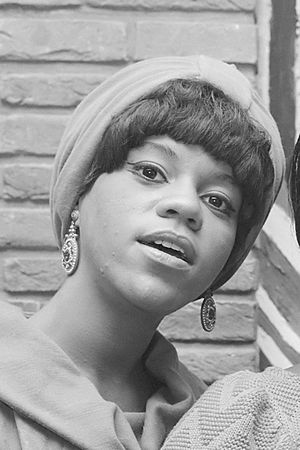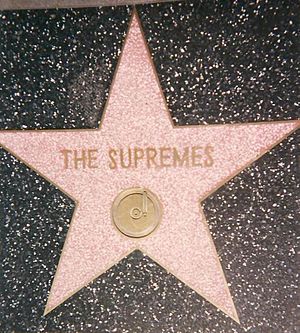Florence Ballard facts for kids
Quick facts for kids
Florence Ballard
|
|
|---|---|

Ballard in 1965
|
|
| Born |
Florence Glenda Ballard
June 30, 1943 |
| Died | February 22, 1976 (aged 32) Detroit, Michigan, U.S.
|
| Resting place | Detroit Memorial Park Cemetery |
| Other names | Florence Chapman |
| Occupation | Singer |
| Years active | 1959–1970, 1975–1976 |
| Spouse(s) |
Thomas Chapman
(m. 1968) |
| Children | 3 |
| Musical career | |
| Genres | |
| Instruments | Vocals |
| Labels | |
| Associated acts |
|
Florence Glenda Chapman (born Florence Ballard; June 30, 1943 – February 22, 1976) was an American singer. She was a founding member of the famous Motown girl group, The Supremes. With the group, she sang on 16 songs that reached the top 40 on the Billboard Hot 100 chart. This included ten songs that became number-one hits.
After leaving The Supremes in 1967, Florence tried to start a solo singing career with ABC Records. However, her solo efforts were not successful, and she left the label a few years later. Florence faced challenges with her health and money for some time. She was trying to make a musical comeback when she passed away from a heart attack in February 1976, at the age of 32. Many people remember Florence Ballard as a talented singer whose story was a sad part of music history. In 1988, she was honored and added to the Rock and Roll Hall of Fame as a member of The Supremes.
Contents
Early Life and Musical Beginnings
Florence Glenda Ballard was born in Detroit, Michigan, on June 30, 1943. She was one of many children born to Lurlee and Jesse Ballard. Her father, Jesse, was an amateur musician who loved to sing and play guitar. He helped inspire Florence's interest in music and taught her many songs.
The Ballard family moved around Detroit often because of money problems. By the time Florence was 15, they lived in the Brewster-Douglass Housing Projects. Her father passed away from cancer the next year. Florence was known as "Blondie" or "Flo" by her family and friends. She went to Northeastern High School and received vocal coaching.
Florence met Mary Wilson at a middle-school talent show, and they became good friends. Florence dreamed of becoming a singer. She decided to audition for a local Detroit group called The Primes, which was managed by Milton Jenkins. After she was accepted, Florence asked Mary Wilson to join the group too. Another neighbor, Diana Ross, also joined. With Betty McGlown, the group was complete, and Jenkins named them "The Primettes."
The Primettes performed at talent shows and school parties. In 1960, they auditioned for Motown Records. Berry Gordy, the head of Motown, told them to finish high school before trying again. Florence later left high school, but her bandmates graduated.
Music Career with The Supremes
Forming The Supremes
Later in 1960, The Primettes signed a contract with Lu Pine Records. They released two songs, but they did not become popular. The group kept trying to get a contract with Motown. They even offered to clap and sing background vocals for other artists. By the end of 1960, Berry Gordy agreed to let them record songs in his studio.
In early 1961, Gordy said he would sign them if they changed their name. Janie Bradford gave Florence a list of names, and Florence chose "Supremes." The other members were not happy with the name at first. Diana Ross worried people might think they were a male group. But Gordy signed them under the name "The Supremes" on January 15, 1961.
Rising to Stardom
The group had a tough start at Motown. They released eight singles that did not make it onto the Billboard Hot 100 chart. This earned them the nickname "no-hit Supremes." One song, "Buttered Popcorn," which Florence sang lead on, was a small hit in some areas but still did not chart nationally.
In 1962, Florence briefly filled in for Wanda Young of The Marvelettes during a tour. Before their first album, Meet the Supremes, was released in 1962, Barbara Martin left the group. The Supremes then became a trio. After their song "When the Love Light Starts Shining Through His Eyes" became a hit in 1963, Diana Ross became the main lead singer of the group.
In the spring of 1964, The Supremes released "Where Did Our Love Go." This song became their first number-one hit on the Billboard Hot 100. This success led to ten number-one hits recorded by Ross, Ballard, and Wilson between 1964 and 1967. The Supremes' live shows got much better after many rehearsals. Florence sang lead on several songs on their albums, including a cover of Sam Cooke's "(Ain't That) Good News". She often performed the song "People" during live shows.
According to Mary Wilson, Florence's voice was so powerful that she had to stand 17 feet away from her microphone during recording sessions. Marvin Gaye, who Florence sometimes sang backing vocals for, called her "a hell of a singer." Overall, Florence contributed her vocals to ten number-one pop hits and 16 top forty hit singles between 1963 and 1967.
Leaving The Supremes and Solo Attempts
Florence was not happy with the direction the group was taking, even during their successful years. She felt that their busy schedule was causing the group members to grow apart. Florence also believed that Motown Records was changing the group by making Diana Ross the main star.
Florence found it hard to deal with the demands of the music label and had disagreements with Diana Ross and Mary Wilson. Her health challenges sometimes caused her to miss performances and recording sessions. Sometimes, another singer named Marlene Barrow would fill in for Florence on stage. In April 1967, Cindy Birdsong from another group, Patti LaBelle and the Blue Belles, also started to fill in for Florence.
In June, Motown changed the group's name to "The Supremes with Diana Ross." On July 1, 1967, the day after her 24th birthday, Florence was not feeling well during a performance in Las Vegas. Berry Gordy told her to return to Detroit, and Cindy Birdsong officially replaced her. This ended Florence's time with The Supremes.
In August 1967, newspapers reported that Florence had taken a temporary break from the group due to "exhaustion." Florence married her boyfriend, Thomas Chapman, on February 29, 1968. A week before that, Florence and Motown agreed on her release from the label. She received a payment of over $139,000 in royalties and earnings. As part of the agreement, Florence was advised not to use her past membership in The Supremes to promote herself.
In March 1968, Florence signed with ABC Records and released two songs that were not successful. An album she recorded for the label was never released. Her money was mismanaged by her business agency, and she later fired them. Florence continued to perform as a solo artist. In January 1969, she performed at one of newly elected President Richard Nixon's inaugural balls. However, ABC Records dropped Florence in 1970.
Later Years and Comeback Attempt
In July 1971, Florence sued Motown for more royalty payments, but she lost the case. Soon after, Florence and her husband separated, and she lost her home. Facing financial difficulties and health challenges, Florence stayed out of the public eye. In 1972, she moved in with her sister.
In 1974, Mary Wilson invited Florence to rejoin The Supremes, which now included Cindy Birdsong and Scherrie Payne. Diana Ross had left for her successful solo career in 1970. Florence attended, but she only played the tambourine and told Mary she did not want to sing anymore. Later that year, news of Florence's struggles appeared in newspapers. Around that time, Florence received treatment at Henry Ford Hospital. After six weeks of treatment, she slowly started to recover.
In early 1975, Florence received a payment from her former attorney's insurance company. This money helped her buy a new house. Inspired by this, Florence decided to return to singing and got back together with her husband. Florence's first concert performance in over five years happened in Detroit on June 25, 1975. She performed as part of a benefit concert and was backed by a female rock group called The Deadly Nightshade. After this, she started getting requests for interviews, and Jet magazine was one of the first to report on her recovery.
Death
On February 21, 1976, Florence Ballard went to Mt. Carmel Mercy Hospital because she felt numbness in her arms and legs. She passed away at 10:05 AM the next morning from a heart attack. The cause was a blood clot in one of her heart arteries. She was 32 years old. Florence Ballard is buried in Detroit Memorial Park Cemetery in Warren, Michigan.
Legacy and Influence
Florence Ballard's life story has been remembered in many ways by other artists. The 1980 song "Romeo's Tune" by Steve Forbert is dedicated to her memory. In a short story by Stephen King, Florence is imagined as one of the deceased artists performing in a town called "Rock and Roll Heaven."
The 1981 Broadway musical Dreamgirls tells the story of a fictional group called "The Dreams." Many parts of the musical are similar to events in The Supremes' career. The main character, Effie White, like Florence Ballard, is criticized for her weight and is removed from the group. The 2006 movie version of Dreamgirls has even more clear references to Florence's life and The Supremes' story. This includes costumes and album covers that look exactly like The Supremes' originals.
Jennifer Hudson won a Golden Globe Award and an Academy Award for playing Effie White in the Dreamgirls film. In her Golden Globe acceptance speech, Jennifer Hudson dedicated her award to Florence Ballard. The music video for Diana Ross's song "Missing You" honors Florence Ballard, Marvin Gaye, and Paul Williams, all former Motown artists who had passed away. In 1988, Florence was added to the Rock and Roll Hall of Fame as a member of The Supremes, along with Diana Ross and Mary Wilson.
In February 2020, a new play about Florence Ballard called "Dreamgirl Deferred" opened in Houston. In the 2013 Broadway play Motown: The Musical, Florence was played by Sydney Morton. As a member of The Supremes, Florence Ballard was one of eight people to receive a Grammy Lifetime Achievement Award at the 65th Annual Grammy Awards in 2023.
Family Life
Florence started dating Thomas Chapman, a chauffeur for Motown Records, in 1967. They got married in Hawaii on February 29, 1968. They had three daughters: twins Michelle Denise and Nichole Rene (born in 1968), and Lisa Sabrina (born in 1972). Florence and her husband reportedly had some disagreements and she filed for divorce in 1973. However, they got back together in late 1975, before she passed away.
Besides her three daughters, Florence's family included her cousin, the rhythm and blues singer and songwriter Hank Ballard. She was also the aunt of the electronic musician Omar-S.
Discography
Album
- 2002: The Supreme Florence Ballard (This album is a collection of her 1968 recordings for ABC Records and some earlier Motown songs where Florence sang lead with The Supremes.)
Singles
- 1968: "It Doesn't Matter How I Say It (It's What I Say That Matters)" b/w "Goin' Out of My Head" (ABC Records #45-11074A/B)
- 1968: "Love Ain't Love" b/w "Forever Faithful" (ABC Records #45-11144A/B)
Images for kids
See also
 In Spanish: Florence Ballard para niños
In Spanish: Florence Ballard para niños




